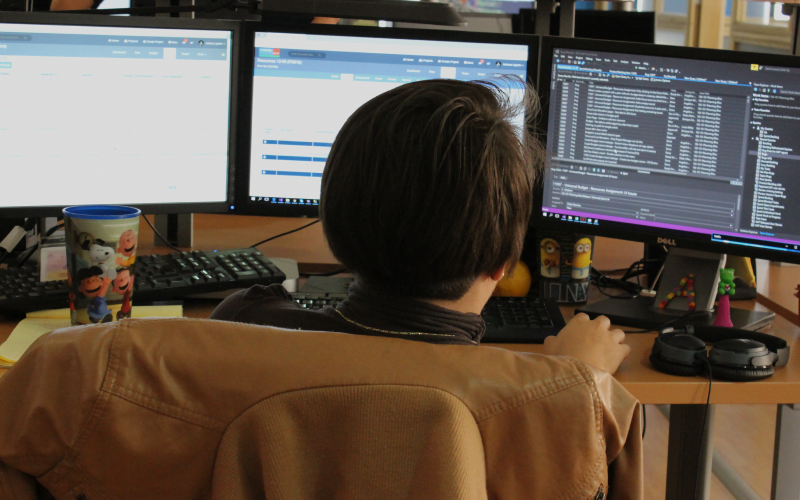
Is your talent distributed or remote?: A new way to look at inclusion in the workplace.
Curated by: Sergio A. Martínez
At this point, the adoption of remote work has become normalized, to the point of (almost) becoming standard in many sectors of the software industry; all said, the option to work away from an office is now a pretty popular perk among developers and engineers all over the world.

However, even if we understand the benefits of this model of collaboration, it doesn’t mean we have completely mastered it yet, and plenty of discussion about the best integration of people beyond the office space is still happening. Mainly, there’s been a lot of talk about the benefits of both remote and distributed work, and while there are certainly some similarities between the two, there are also some important differences that we should know about.
Namely, that one of them is way more inclusive and equitable than the other.
But what do we mean by this? Remote work, as the name suggests, simply involves working from a remote location — usually your home. Distributed work, on the other hand, involves working with a team that is spread out across multiple locations, cultures, and languages. Nearshore development, for example, is a type of distributed work where team members are based in different countries within the same time zone, which allows for esaier collaboration and inclusion, as everyone can participate in meetings and discussions in real-time.
“Distributed work, on the other hand, means that people on the team are decentralized. It means the company has made a conscious decision not to have a “center” that’s more important than any other location. In other words, remote work builds back from the real estate (we have an office, let’s fill it up) whereas distributed work builds forward from the humans doing the work.”
And why is this important? Because nearshore development models are much more inclusive and allow for a greater diversity of voices and perspectives. In an increasingly globalized world, it’s more important than ever that we find ways to work together that are respectful of different cultures and traditions. Nearshore development helps to make this possible.
The importance of diverse perspectives

There are a lot of reasons why diversity and inclusion are important in software development. For one, it helps to create a more collaborative environment, because people who come from different backgrounds, and have different experiences, can share unique perspectives and skill sets to make a more innovative and effective software development; after all, if you’re developing software with the help of a diverse group of people, the end result will be more inclusive for a vast range of people using, making it stronger and potentially more successful.
Additionally, diversity and inclusion help create a more positive work environment, as an employee that feels respected and valued is more likely to be engaged and productive, as well as attract and retain top talent. When employers manage to shift their way of conceptualizing the traditional office and look for talent beyond this setup, they can discover that the best talent doesn’t necessarily have to be in a specific place; by creating an inclusive environment, they signal that they are committed to attracting diverse candidates, which can include the best and brightest from any backgrounds.
Ultimately, diversity and inclusion lead to better software development, and a more positive work environment.
“The collaboration that Nearshore development creates between businesses and software developers, taking place in countries that are geographically close to one another, has many benefits, but one of the most important is that it helps to promote inclusion by breaking down barriers”, says Luis Aburto, CEO, and Co-Founder of Scio, an organization based around collaboration all over LATAM.
So naturally, a more distributed workplace that can reach this variety of voices is the best approach to ensure that inclusion and diversity flourish within an organization. The problem, however, comes when the structure of an organization becomes purely remote instead of distributed, and the advantages of diversity and inclusion start to become diluted. In the words of Jensen Harris, CTO at the software platform Textio:
“When there’s a center — a headquarters or physical office with just some team members who are remote — there’s a power differential. […] Some employees can work with them in person, while others are “just remote.” The result? Employees working at headquarters see their leadership more. They’ll get noticed more, run into a VP in the kitchen and when it’s time for a promotion, the VP feels like she knows the guy she’s seen in person better than the remote staff. It’s just human nature.”
In Scio’s experience, though, a strong enough culture can ease many of these issues in regards to visibility and working relationships, promoting in-house activities that encourage an understanding that goes beyond the workplace: video-call meetups and activities, for example, can bring a team closer and build the rapport necessary to keep everyone on the same page, and thus ensure a seamless collaboration during any development cycle.
The challenge of diversity in distributed teams

However, this doesn’t mean that a distributed workplace isn’t without challenges. When it comes to Nearshore development, where both the teams and the clients share a time zone but are still spread geographically, one of the biggest barriers to inclusion is language. When businesses and developers are working in different countries, there is a potential for misunderstanding and miscommunication that can lead to frustration on both sides and ultimately make it difficult to get work done. Nearshore development helps to reduce the risk of this happening by allowing businesses and developers to work in the same language, which in the case of Scio, is easy to achieve thanks to the proximity of the US (from where most of our clients hail) to the rest of LATAM, especially Mexico.
Still, beyond language, a challenge to inclusion is culture. When businesses and developers are from very different cultures, there can be a lack of understanding and respect for each other’s traditions, which can again lead to frustration and difficulty getting work done. Nearshore collaboration helps to reduce the risk of this happening by bringing businesses and developers from similar cultures together; for example, with LATAM being very close to the US, there are shared traditions and knowledge of each other’s cultures that benefit any collaboration between these territories.
There are many other benefits of nearshore collaboration, but these two are some of the most important when it comes to promoting inclusion. By breaking down barriers like language and culture, nearshore collaboration helps to create an environment where everyone can feel respected and valued. And that’s something we can all get behind.
Evolving our understanding of remote work
The way people work is changing, and companies are starting to catch on. There is a growing movement of companies that are ditching the traditional 9-5 in favor of a more distributed model, where employees can work from anywhere in the world.
“Before the COVID-19 crisis, a survey of office workers by 451 Research showed that two-thirds of people worked from home at least some of the time but only 13% did so all of the time”, cites the Dropbox blog Work In Progress. “For these companies, the social contract for employment is not about showing up physically, but showing up mentally and engaging fully from wherever you are. The employees commit to being part of the team and doing the work, and the employer commits to making both possible.”
There are a lot of benefits to this model. For one, it allows companies to tap into a global talent pool. It also gives employees a lot more freedom and flexibility when it comes to their work-life balance, but there are also a few challenges that come with this model. One of the biggest is making sure that everyone feels included, no matter where they are located. After all, as the quoted Work In Progress blog concludes: “companies that merely tolerate remote workers rarely expend the effort to make them part of the daily rhythms and incidental interactions at HQ”, and will rarely keep their remote top talent.
So understanding both the advantages and limits of a distributed workplace, where “remote” means more than just having someone with a computer connected from far away, is the next step for the new landscape of collaboration that is changing our approach to software development. As a Nearshore company, we understand the value that diversity and inclusion can have in every successful project we collaborate on.
The Key Takeaways

- Working away from the office is an increasingly popular model of collaboration that the software industry is starting to adopt openly.
- However, there’s a challenge in understanding the difference between mere remote work, and a distributed organization, which can be crucial for the success of an organization.
- While “remote work” works well with collaborators that are still local (to a point) or with hybrid models, a distributed workforce with people permanently far away requires a different approach.
- A strong culture that builds connections between clients and teammates beyond work is better equipped to deal with challenges and obstacles.
- And more importantly, a distributed workplace tends to be more inclusive and diverse, which enriches the software development environment and leads to better solutions for everyone.
Scio is an established Nearshore software development company based in Mexico that specializes in providing high-quality, cost-effective technologies to help you reach new heights. We have been developing since 2003 and our experience gives us access not only to the knowledge but also the expertise needed when tackling any project. Get started today by contacting us about your project needs – we’ll be happy to help you achieve your business goals.






